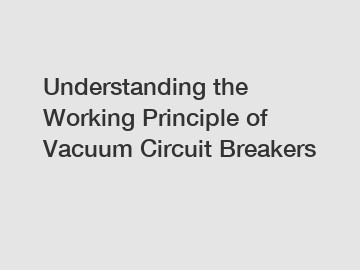Understanding the Working Principle of Vacuum Circuit Breakers
Vacuum circuit breakers are an essential component in the field of electrical engineering, playing a crucial role in the protection and control of electrical circuits. Understanding their working principles is key to ensuring the efficient and safe operation of electrical systems. In this blog post, we will explore the intricate workings of vacuum circuit breakers, shedding light on the technology behind these devices.
To begin with, let's take a look at what exactly a vacuum circuit breaker is and why it is used in electrical systems. A vacuum circuit breaker is a type of circuit breaker that uses a vacuum as the arc extinguishing medium. When a fault occurs in an electrical circuit, a high current passes through the system, creating an arc between the contacts of the circuit breaker. It is the job of the circuit breaker to extinguish this arc and interrupt the flow of current in order to protect the system from damage.
The use of a vacuum as the arc extinguishing medium in a circuit breaker offers several advantages over other types of circuit breakers. Vacuum circuit breakers are highly efficient at extinguishing arcs, as the absence of any gas or air in the vacuum chamber eliminates the possibility of an arc reigniting. This results in faster interruption times and greater reliability in the operation of the circuit breaker.

The working principle of a vacuum circuit breaker is based on the concept of metal vaporization. When the circuit breaker is closed, a high current flows through the contacts, generating intense heat that vaporizes the contact material. This vaporization creates a high-pressure plasma that quickly extinguishes the arc, allowing the contacts to separate and interrupt the current flow.
One of the key components of a vacuum circuit breaker is the vacuum interrupter, which is responsible for extinguishing the arc and interrupting the current flow. The vacuum interrupter consists of two contacts housed in a sealed vacuum chamber. When the circuit breaker is closed, the contacts come into contact with each other, allowing the current to flow through the system. When a fault occurs, the contacts are quickly separated, creating an arc that is extinguished by the vacuum medium.
The vacuum interrupter operates on the principle of magnetic blowout, which uses the magnetic field produced by the current flow to force the arc into a spiral path. This spiral path increases the length of the arc, allowing it to cool and extinguish more quickly. The combination of metal vaporization and magnetic blowout results in a highly efficient arc extinguishing process that ensures the reliable operation of the circuit breaker.
In addition to their efficiency and reliability, vacuum circuit breakers also offer a number of other advantages. They are compact in size, making them ideal for applications where space is limited. They are also environmentally friendly, as they do not release any harmful gases or pollutants into the atmosphere. Furthermore, vacuum circuit breakers have a long service life and require minimal maintenance, making them a cost-effective choice for a wide range of applications.
In conclusion, vacuum circuit breakers are a critical component in modern electrical systems, providing efficient and reliable protection against faults and overloads. By understanding the working principles of vacuum circuit breakers, electrical engineers can ensure the safe and efficient operation of electrical systems. With their high degree of expertise and authority in the field of electrical engineering, vacuum circuit breakers are a vital tool in the arsenal of any electrical engineer.
If you want to learn more, please visit our website hv automatic reactive power compensation panels, fixed-mounted switchgear price, bokrelec.com.
146
0
0


Comments
All Comments (0)